Making organic soap is similar to making other types of homemade soap. The only difference is that you will use organic soap-making supplies.
Except for lye, organic soaps contain only organic ingredients. Because of the moisturizing effect of its quality ingredients, organic soap cleanses your skin better and leaves it feeling fresh, smelling wonderful, and soft.
The steps below will show you how to make your own organic soap at home.
Ingredients for 4 bars of soap
- 2.14 oz (60 g) of food-grade lye (sodium hydroxide)
- 4.5 fluid ounces (130 mL) of distilled water
- 12 fluid ounces (350 mL) of olive oil
- 1.5 fluid ounces (44 mL) of castor oil
- 2.5 fluid ounces (74 mL) of melted coconut oil
- 1 tbsp (15 mL) of essential oil in a favorite scent
Materials
- Kitchen scale
- 4 by 4 in (10 by 10 cm) silicone soap mold
- 2 heat-resistant stainless steel pitchers
- Double boiler setup
- Stainless-steel spoon
- Stainless steel thermometer
- Immersion blender
- Rubber spatula
- Freezer or parchment paper
- Old towels or cloths
- Measuring cups and measuring spoons
Instructions
This will be divided into three parts
- Creating the lye and oil solutions
- Mixing the soap batter
- Molding and curing the soap
Creating The Lye And Oil Solutions
1. Use a kitchen scale to properly measure out your ingredients
Having accurately measured ingredients is crucial to making soap successfully. If some of the ingredients are measured incorrectly, the skewed ratio could be significant enough to keep the soap from solidifying or curing properly.
- If you don’t have a kitchen scale, you can purchase one in the kitchen or housewares section at a local department store, or you can order one online through major retailers.
- Any container, utensils, molds, or pitchers used to measure or make the soap should not be used to work with food. The contamination caused by the lye would not be safe for consumption.
2. Wear protective clothing when working with lye
Lye is caustic and you want to avoid getting it on your skin or near your face. To protect your skin while working with the lye, wear long sleeves, gloves, and goggles. Avoid breathing in the fumes by working near an open window, or by having a fan circulate the air.
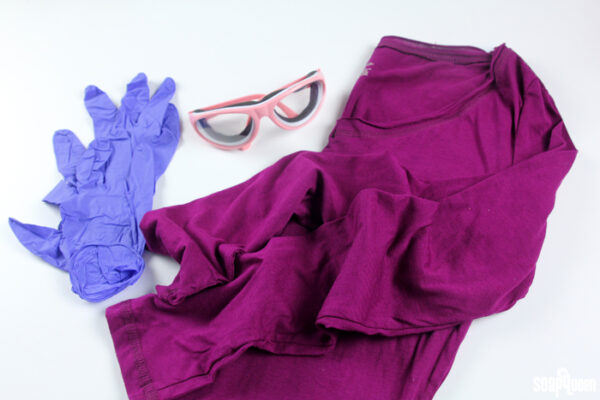
- If you have breathing problems or are concerned about breathing in the lye fumes while working with it, wear a respirator mask. You can purchase one at your local hardware store or online with major retailers.
3. Pour 4.5 fl oz (130 mL) of distilled water into a stainless steel pitcher
Use a thick, durable plastic pitcher if you do not have a stainless steel one. Avoid using aluminum, as the lye will negatively react to the element.
4. Stir in 2.14 oz (60 g) of food-grade lye to the pitcher with the water
Pour the lye slowly to keep it from plopping into the water. Use a silicone spatula to stir the water as you pour in the lye. Continue stirring the mixture to dissolve the lye.
- Always add the lye second to the water. Pouring the water directly onto the lye will prematurely start the chemical reaction and heat up the lye.
5. Allow the lye solution to cool down for 30-40 minutes
Be careful when handling or transporting the lye solution. The natural chemical reaction of the lye with the water will create a hot solution.
- When mixed with water, lye can reach temperatures as high as 200 °F (93 °C). Even after you have let it cool down the solution will still be considerably hot—around 100–110 °F (38–43 °C).
6. Heat up the coconut oil in a double boiler to melt any solidified parts
Stir the coconut oil over a low heat to keep it from bubbling or burning. Once all solidified remnants of the oil have melted, remove it from the heat.
- A similar product to coconut oil is babassu oil, which is a vegetable oil that comes from the babassu palm in South America. Use equal amounts of this oil if you are allergic to the coconut oil, or if you want to try something different.
7. Mix the oils in a second stainless steel pitcher to make the soap batter
Add 12 fluid ounces (350 mL) of olive oil, 1.5 fluid ounces (44 mL) of castor oil, and 2.5 fluid ounces (74 mL) of melted coconut oil. The castor oil will create the lather in the bar of soap when used, the olive oil will soften and condition your skin, and the coconut oil will help harden the soap.
- The coconut oil will be hot, so be careful when mixing it with the other oils.
Mixing The Soap Batter
1. Add the lye solution to the pitcher with the oils to make the soap batter
Pour in the mixture slowly to avoid spilling it. Be careful not to burn yourself, as both the lye and the oils are hot.
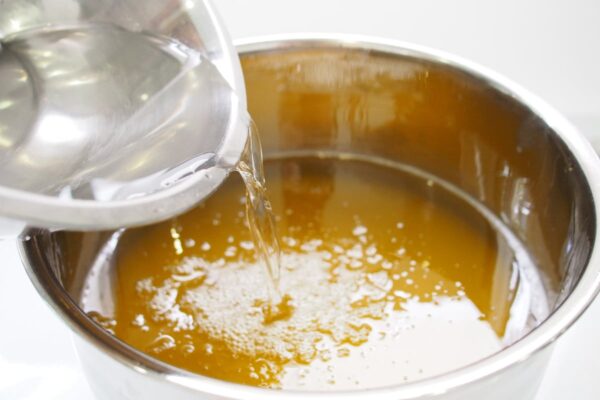
- The temperature of the oils and lye solution should be around 100–110 °F (38–43 °C). Use a stainless steel thermometer to check this before mixing the two solutions. If the oil temperature is lower, heat in the double boiler until the temperatures are about the same.
2. Stir the solution with a stainless steel spoon to combine the ingredients
Any stainless steel spoon will work fine, but it will be easier to stir the mixture if the spoon has a long handle. Continue to gently stir the mixture for about 30 seconds. This will give the lye and oils a chance to mix before you blend them more thoroughly.
- If you do not have a stainless steel spoon or one with a long enough handle, use an immersion blender in the off-position to gently mix the ingredients.
3. Add special clay minerals, sugar, flowers, or herbs to color your soap
Pick an ingredient that will change the appearance of the soap to match your favorite color. As is, the olive oil used to make the soap will give it a yellow or cream color after it is cured. If you enjoy or don’t mind that color, don’t add extra ingredients.[13]
- Add in a dash of cosmetic clays to change the soap color to pink, green, or white.
- Use a couple of drops of milk, cane sugar, or honey to give the soap a warm caramel color.
- For more vibrant colors, use the petals or leaves from your favorite flowers or herbs. For example, alkanet root will give the soap a purple hue and spinach leaves make the soap green.
4. Blend the solution for 1 minute with an immersion or stick blender
Submerge the bladed portion of the immersion blender into the mixture before turning it on; otherwise, the immersion blender will fling the solution out of the pitcher. Slowly rotate the immersion blender around the base of the pitcher to blend the solution.
- If there are multiple speed settings for your immersion blender, have it on the lowest setting. Quickly pulsating the solution will create unnecessary air bubbles in your soap batter.
- If you do not have an immersion or stick blender, you can purchase one at a local department store or online.
5. Alternate between stirring and blending the batter to thicken it
Use the immersion blender in the off-position to stir the batter. Switching between the spoon and immersion blender may cause you to drip or spill the batter. Continue this process for about 10-15 minutes.
- For soap making, thickened soap batter is called “trace.” This means that the batter is thick enough for you to drip some onto the surface of the batter and have it remain on the surface. When a soap reaches this consistency, it no longer needs to be mixed and is ready to be poured into the mold.
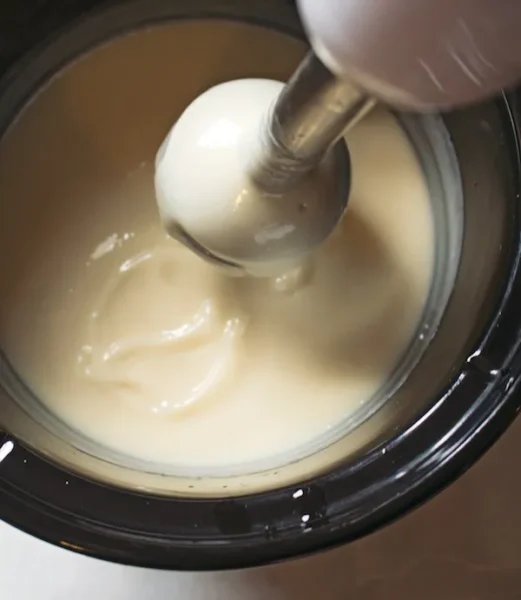
6. Add essential oils to the trace soap batter to give it a desired scent
Start by adding 1 US tbsp (15 mL) of the oil and stir it into the batter using your stainless steel spoon. The essential oils will smell stronger when added to the batter than when the batter is cured. So if the scent is not strong in the batter, add more in small increments until you can smell it.
- Soaps that use a higher ratio of water to olive oil will only need to be cured for 4-6 weeks instead.
- If you used a loaf silicone mold, use a knife to carefully cut the loaf of soap into 4 equally sized bars before curing them.
- Some common essential oils to add are vanilla, almond, lavender, lemongrass, geranium, or peppermint.
Molding And Curing The Soap
1. Pour the batter into a 4 in (10 cm) silicone soap mold to shape it
Use a mold that will create 4 rectangular bars of soap. A standard mold will have an approximate 4 by 4 in (10 by 10 cm) length and width, and 3 in (7.6 cm) height. You can find one of these molds at a local craft store or online with major retailers.
- Consider getting a silicone mold that has a fun pattern or design on it to further personalize your homemade soap. You can also use a loaf mold that is not sectioned off and just cut the soap into individual bars later.[18]
- Avoid using muffin tins or baking pans as the soap batter will most likely ruin the tins and the soap.
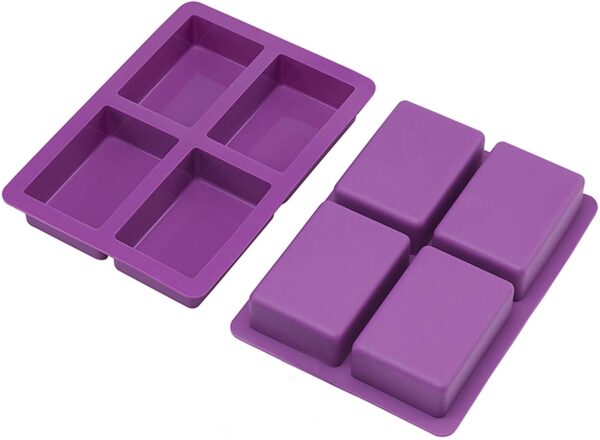
2. Cover the filled mold with freezer paper and a towel to trap the heat
Leave the soap covered for at least 24 hours, but check on it periodically to make sure that it is not overheating and cracking. If it develops cracks, leave it covered, but move it to a cooler location like a dark closet or a cool basement.
- Use freezer paper over standard wax paper, as freezer paper is thicker and the wax paper might melt against the heat of the soap batter. You can also use parchment paper.
3. Uncover the mold and leave it to firm up over the next 2-3 days
Check on the soap at least once a day to make sure that it’s hardening properly and has not been disturbed. You will notice that the texture of the soap batter will gradually change to a gelatinous state over the 3 days. By the third day, it should seem fairly firm if you touch it with your finger.
4. Pop the soap bars out of the silicone mold to cure them
Place the bars in an area out of direct sunlight, and leave them alone for at least 6-8 weeks. The air will dry out and fully harden the soap. After that time, the soap will be ready for you to use and enjoy.
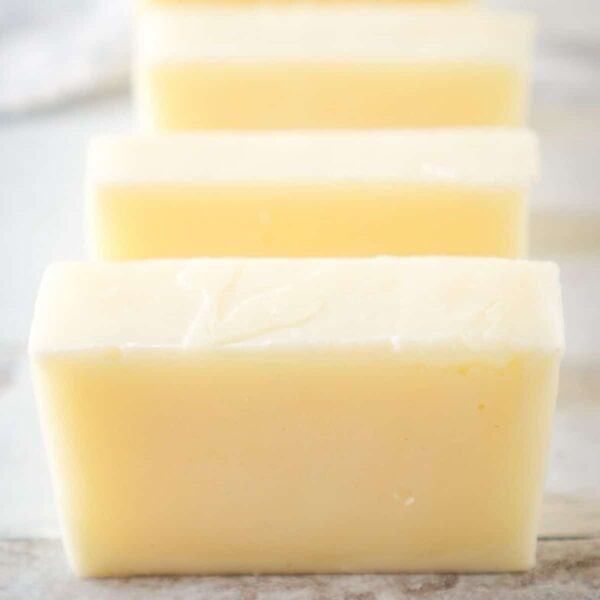
- Soaps that use a higher ratio of water to olive oil will only need to be cured for 4-6 weeks instead.
- If you used a loaf silicone mold, use a knife to carefully cut the loaf of soap into 4 equally sized bars before curing them.






